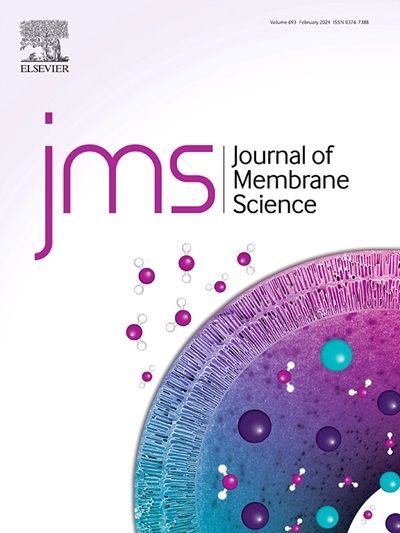Structural engineering of matrimid using an amino-terminated polydimethylsiloxane crosslinker to enhance CO2 permeability
IF 8.4
1区 工程技术
Q1 ENGINEERING, CHEMICAL
引用次数: 0
Abstract
Polyimides have been utilized for gas separation because of their high gas diffusivity selectivity. Matrimid is one of glassy polyimides that show high selectivity for CO2/light gases. However, its applications for gas separation have been limited due to its low gas permeability. We report here a novel and facile method to enhance its gas permeability by crosslinking it with high molecular weight poly(dimethylsiloxane) bis(3-aminopropyl) terminated (PDMS-NH2). PDMS-NH2 was chosen because of its known high gas permeability due to its flexible siloxane linkages. The structural rearrangement and chemical interactions between Matrimid and PDMS-NH2 were investigated using various characterization methods. Both XRD and position annihilation lifetime spectroscopy (PALS) results confirmed that the d-spacing and fractional free volume (FFV) significantly increased after incorporating PDMS-NH2 into the Matrimid polymer matrix. The EDX elemental mapping of both top and cross-sectional surfaces show uniform distributions of elements. The resultant membranes display synergistic separation performance, not only exhibiting high gas permeability but also maintaining high CO2/N2 selectivity close to Matrimid. Specifically, the additions of 10, 25, and 50 wt% of PDMS-NH2 into the Matrimid matrix enhance the CO2 permeability from the initial 12.01 to 58.22, 82.60, and 260.51 Barrer, respectively (i.e., increasing CO2 permeability by about 385 %, 588 %, and 2069 %, respectively) without much compromise in CO2/N2 selectivity. Interestingly, the mixed gas tests have higher CO2/N2 selectivity than those pure gas tests, possibly due to strong interactions between CO2 and the amine groups of PDMS-NH2. In addition, the plasticization phenomenon of the Matrimid/PDMS-NH2 membranes reduces due to the less CO2 adsorption. Dual-mode sorption analyses indicate the shift of separation mechanism from a diffusivity-selectivity controlled one in the Matrimid membrane to a solubility-selectivity controlled one in the 50/50 Matrimid/PDMS-NH2 membrane. Comparing with other studies, the newly developed membranes show a relatively higher CO2 permeability, while exhibiting a comparable CO2/N2 selectivity. This study may provide new insights to design advanced polymeric membrane materials for CO2 capture.

求助全文
约1分钟内获得全文
求助全文
来源期刊

Journal of Membrane Science
工程技术-高分子科学
CiteScore
17.10
自引率
17.90%
发文量
1031
审稿时长
2.5 months
期刊介绍:
The Journal of Membrane Science is a publication that focuses on membrane systems and is aimed at academic and industrial chemists, chemical engineers, materials scientists, and membranologists. It publishes original research and reviews on various aspects of membrane transport, membrane formation/structure, fouling, module/process design, and processes/applications. The journal primarily focuses on the structure, function, and performance of non-biological membranes but also includes papers that relate to biological membranes. The Journal of Membrane Science publishes Full Text Papers, State-of-the-Art Reviews, Letters to the Editor, and Perspectives.
 求助内容:
求助内容: 应助结果提醒方式:
应助结果提醒方式:


